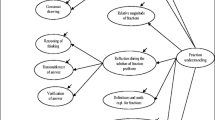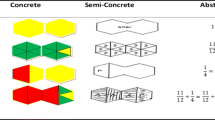Abstract
Fractions are an important part of the primary school mathematics curriculum, being introduced to children in the Slovenian educational system during the second grade (at age seven). For clarification of terms it is worth mentioning that the term “fraction” is only introduced in the sixth grade. Before that, the term “equal parts of a given whole” (In Slovene language, there are two different terms which are used in teaching about fractions: one is “equal parts of a given whole” as deli celote and another is “fraction” as ulomek. Fraction in our elementary school has the meaning of all other subconstructs proposed by Kieren (1976) except part-whole subconstruct. This subconstruct is covered by another term, namely “deli celote.” For easier understanding, we use in this paper only the term “fraction.”) is used. When we speak about “fractions” in primary school, we actually speak about parts of a given whole where the whole could be a set of objects or a single object that can be divided into equal parts. We used the fractional scheme theory for the theory framework of our research, focusing mainly on “parts within the whole,” the “part-whole” fraction scheme, and, to some extent, the “partitive unit” fraction scheme. Ninety fifth-grade pupils took a test we developed with the aim of achieving a better understanding of the field of pupils’ understanding of the part-whole aspect of fractions. More precisely, we were interested in how pupils understood the idea of dividing a whole into equal parts: is the idea of dividing mainly connected to dividing into congruent parts, are pupils able to reason about equal parts as parts of equal area, and do they adapt their reasoning according to the demands of the problems. The test consisted of four problems, each of them divided into parts (a total of eight problems to solve altogether). We used descriptive statistics and qualitative research based on the grounded theory method to process the data gathered from how participants solved the problems. We used the inductive process to determine how to categorize the responses and find relationship between the different categories. The findings showed that at the end of the fifth grade, pupils did not yet master the part-whole subconstruct of fractions and had problems related to linking congruency and parts of the whole. The mistakes pupils made clearly showed that a number of types of misunderstandings were prevalent: for example, not being able to connect the idea of fractions to equal parts of the whole or connecting the idea of fractions only to congruent parts of the whole as well as mistakes related to determining what part of the whole is presented.











Similar content being viewed by others
Notes
We got the idea for problem 3 from Professor Marianne Ciosek whom we met at the 2012 CME conference in Poland. The problem is not exactly the same as discussed with this professor but an adapted version.
References
Behr, M., Harel, G., Post, T., & Lesh, R. (1993) Rational numbers: towards a semantic analysis-emphasis on the operator construct. In: T. P. Carpenter, E. Fennema & T.A. Romberg (Eds.), Rational numbers: an integration of research (pp. 13-47). New York: Lawrence Erlbaum Associates.
Behr, M. J., Harel, G., Post, T. R., & Lesh, R. (1992). Rational number, ratio and proportion. In D. Grouws (Ed.), Handbook of research on mathematics teaching and learning (pp. 296–333). New York: Macmillan.
Behr, M. J., Lesh, R., Post, T. R., & Silver, E. A. (1983). Rational number concept. In R. Lesh & M. Landau (Eds.), Acquisitions of mathematics concepts and processes (pp. 91–126). New York: Academy Press.
Carraher, D. W. (1996). Learning about fractions. In L. P. Steffe, P. Nesher, P. Cobb, G. A. Goldin, & B. Geer (Eds.), Theories of mathematical learning (pp. 241–266). Mahwah: Lawrence Erlbaum.
Castro-Rodríguez, E., Pitta-Pantazi, D., Rico, L., & Gómez, P. (2016). Prospective teachers’ understanding of the multiplicative part-whole relationship of fraction. Educational Studies in Mathematics, 92(1), 129–146.
Charalambous, C. Y., & Pitta-Pantazi, D. (2007). Drawing on theoretical model to study students’ understanding of fractions. Educational Studies in Mathematics, 64(3), 293–316.
Clarke, D., Roche, A. & Mitchell, A. (2007). Year six fraction understanding: A part of the whole story. In J. Watson & K. Beswick (Eds.), Mathematics: Essential research, essential practice. Proceedings of the 30 th annual conference of the mathematics education research group of Australia (Vol. 1, pp. 207–216). Adelaide: MERGA Inc.
Confrey, J. (1988). Multiplication and splitting: Their role in understanding exponential functions. In M. Behr, C. Lacampagne, & M. Wheeler (Eds.), Proceedings of the tenth annual meeting of the north american chapter of the international group for the psychology of mathematics education (pp. 250–259). DeKalb: Northern Illinois University Press.
Confrey, J., & Smith, E. (1995). Splitting, covariation and their role in the development of exponentional functions. Journal for Research in Mathematics Education, 26(1), 66–86.
Davis, G. E. (1989). Attaiment of rational number knowledge. In N. Ellerton & K. Clements (Eds.), The challenge to change (pp. 31–42). Victoria: Mathematical Association of Victoria.
Empson, B. S., & Levi, L. (2011). Extending children’s mathematics: Fractions and decimals. Portsmouth: Heinemann.
English, L. (1995). Cognitive psychology and mathematics education. In L. D. English & G. S. Halford (Eds.), Mathematics education: Models and processes (pp. 1–20). Mahwah: Lawrence Erlbaum Associates.
Freudenthal, H. (1983). Didactical phenomenology of mathematical structures. Dordrecht: Reidel.
Hackenberg, A. (2007). Units coordination and construction of improper fractions: A revision of the splitting hypothesis. The Journal of Mathematical Behaviour, 26(1), 27–47.
Hackenberg, A., & Tillema, E. S. (2009). Students’ whole number multiplicative concepts: A critical constructive resource for fraction composition schemes. The Journal of Mathematical Behaviour, 28, 1–18.
Hackenberg, A. J. (2013). The fractional knowledge and algebraic reasoning of students with the first multiplicative concept. The Journal of Mathematical Behaviour, 32, 538–563.
Hannula, M. S. (2003). Location fractions on number line. In N. A. Pateman, B. J. Dougherty, & J. T. Zillox (Eds.), Proceedings of the 27 th conference of the international group for the psychology of mathematics education (Vol. 3, pp. 17–24). Honolulu: PME.
Hunting, R. P., & Sharpley, C. F. (1991). Pre-fraction concepts of preschoolers. In R. P. Hunting & G. Davis (Eds.), Early fraction learning (pp. 9–26). New York: Springer-Verlag.
Keijzer, R., & Terwel, J. (2001). Audrey’s acquisition of fractions: A case study into the learning of formal mathematics. Educational Studies in Mathematics, 47(1), 53–73.
Kieren, T. E. (1976). On the mathematical, cognitive and instructional foundations of rational numbers. In R. A. Lesh (Ed.), Number and measurement: Papers from a research workshop (pp. 101–144). Columbus: ERIC/SMEAC.
Kieren, T. E. (1988). Personal knowledge of rational numbers: Its intuitive and formal development. In M. Behr & J. Hiebert (Eds.), Number concepts and operations in the middle grades (pp. 162–181). Reston: National Council of Teachers of Mathematics, Inc..
Kieren, T. E. (1993). Rational and fractional numbers: From quotient fields to recursive understanding. In T. P. Carpenter, E. Fennema, & T. A. Romberg (Eds.), Rational numbers: An integration of research (pp. 49–84). New Jersey: Erlbaum.
Lamon, S. J. (1999). Teaching fractions and ratios for understanding: Essential content knowledge and instructional strategies for teachers. Hillsdale: Erlbaum.
Lamon, S. J. (2007). Rational numbers and proportional reasoning: Toward a theoretical framework for research. In F. K. Lester Jr. (Ed.), Second handbook of research on mathematics teaching and learning (pp. 629–668). Charlotte: Information Age.
Mack, N. K. (1993). Learning rational numbers with understanding: The case of informal knowledge. In T. P. Carpenter, E. Fennema, & T. A. Romberg (Eds.), Rational numbers: An integration of research (pp. 85–106). Hillsdale: Erlbaum.
Moss, J. (2005). Pipes, tubes, and beakers: Teaching rational number. In J. Bransford & S. Donovan (Eds.), How children learn: History science and mathematics in the classroom. Washington DC: National Academy Press.
Moss, J., & Case, R. (2011). Developing children’s understanding of the rational numbers: A new model and an experimental curriculum. Journal for Research in Mathematics Education, 30(2), 122–147.
Neuman, D. (1993). Early conceptions of fractions: A phenomenographic approach. In I. Hirabayashi, N. Nohda, K. Shigematsu, & F. Lin (Eds.), Proceedings of the seven-teeth international conference for the psychology of mathematics education (Vol. III, pp. 170–177). Tsukuba City: University of Tsukuba.
Ni, Y. (2001). Semantic domains of rational numbers and the acquisition of fraction equivalence. Contemporary Educational Psychology, 26, 400–417.
Norton, A. (2008). Josh’s operational conjectures: Abductions of a splitting operation and the construction of new fractional schemes. Journal for Research in Mathematics Education, 39(49), 401–430.
Norton, A., & Wilkins, J. L. M. (2012). The splitting group. Journal for Research in Mathematics Education, 43(5), 557–583.
Novillis-Larson, C. (1980). Locating proper fractions. School Science and Mathematics, 53(5), 423–428.
Ohlsson, S. (1988). Mathematical meaning and applicational meaning in the semantics of fractions and related concepts. In J. Hiebert & M. Behr (Eds.), Research agenda for mathematics education: Number concepts and operations in the middle grades (pp. 55–92). Reston: Lawrence Erlbaum Associates.
Pantziara, M., & Philippou, G. (2012). Levels of students’ ‘conception’ of fractions. Educational Studies in Mathematics, 79(1), 61–83.
Park, J., Güçler, B., & McCroy, R. (2013). Teaching prospective teachers about fractions: Historical and pedagogical perspectives. Educational Studies in Mathematics, 82, 455–479.
Piaget, J., Inhelder, B., & Szeminska, A. (1960). The child’s conception of geometry. New York: Basic Books.
Pitkethly, A., & Hunting, R. (1996). A review of recent research in the area of initial fraction concepts. Educational Studies in Mathematics, 30(1), 5–38.
Post, T. R., Behr, M. J., & Lesh, R. (1982). Interpretaion of rational number concepts. In L. Silvey & J. Smart (Eds.), Mathematics for grades 5–9, 1982 NCTM yearbook (pp. 59–72). Reston: NCTM.
Post, T., Harel, G., Behr, M., & Lesh, R. (1988). Intermediate teachers knowledge of rational number concepts. In E. Fennema, T. P. Carpenter, & S. J. Lamon (Eds.), Papers from first Wisconsin symposium for research on teaching and learning mathematics (pp. 194–219). Madison: WCER.
Pothier, Y., & Sawada, D. (1983). Partitioning: The emergence of rational numbers ideas in young children. Journal for Research in Mathematics Education, 14(5), 307–317.
Siegler, R., Carpenter, T., Fennel, F., Geary, D., Lewis, J., Okamoto, L., … Wray, J. (2010). Developing effective fractions instruction for kindergarten through 8th grade: A practice guide. Washington, DC: National Center for Education Evaluation and Regional Assistance, Institute of Education Sciences, U.S. Department of Education.
Steffe, L. P. (2002). A new hypothesis concerning children’s fractional knowledge. Journal for Mathematical Behaviour, 20, 267–307.
Steffe, P. L., & Olive, J. (2010). Children’s fractional knowledge. New York: Springer.
Streefland, L. (1991). Fractions in realistic mathematics education: A paradigm of developmental research. Dordrecht: Kluwer Academic Publishers.
Streefland, L. (1993). Fractions: A realistic approach. In T. P. Carpenter, E. Fennema, & T. A. Romberg (Eds.), Rational numbers: An integration of research (pp. 289–325). Hillsdale: Lawrence Erlbaum Associates.
Tunç-Pekkan, Z. (2015). An analysis of elementary school children’s fractional knowledge depicted with circle, rectangle, and number line representations. Educational Studies in Mathematics, 89, 419–441.
Vergnaud, G. (1983). Multiplicative structures. In R. Lesh & M. Landau (Eds.), Acquisition of mathematics concepts and processes (pp. 127–174). New York: Academic Press.
Author information
Authors and Affiliations
Corresponding author
Rights and permissions
About this article
Cite this article
Čadež, T.H., Kolar, V.M. How fifth-grade pupils reason about fractions: a reliance on part-whole subconstructs. Educ Stud Math 99, 335–357 (2018). https://doi.org/10.1007/s10649-018-9838-z
Published:
Issue Date:
DOI: https://doi.org/10.1007/s10649-018-9838-z




